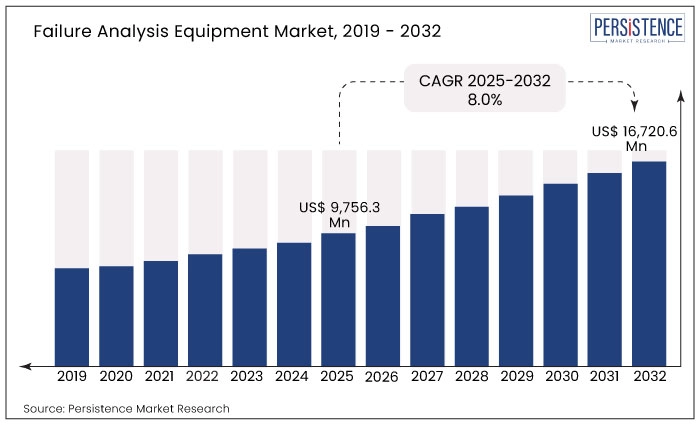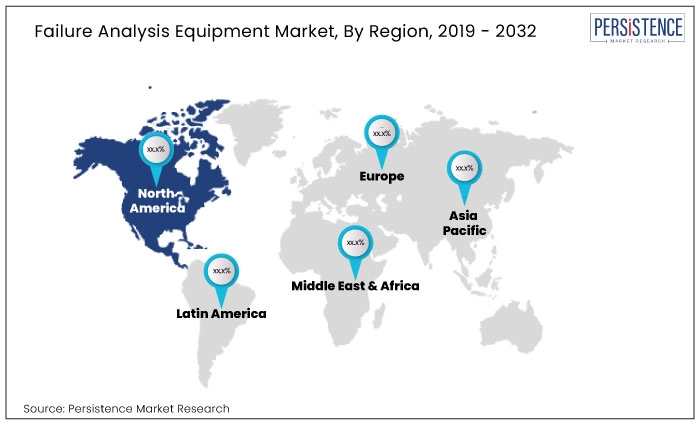ID: PMRREP33445| 195 Pages | 18 Jul 2025 | Format: PDF, Excel, PPT* | Semiconductor Electronics

The global failure analysis equipment market is expected to be worth US$ 9,756.3 Mn by 2025, growing at a 8.0% CAGR between 2025 and 2032. The market is projected to reach US$ 16,720.6 Mn by 2032.
The use of failure analysis techniques is an important tool for a wide range of industries, particularly for developing new products and improving the efficiency of existing equipment and machinery.
For an improved use of current assets and machinery in the oil & gas industry, equipment helps prevent service failures and safety incidents. Microelectronics, sophisticated and complex electronics, and advancements in failure analysis technology are expected to drive the global failure analysis equipment market during the forecast period.
In the coming years, new microelectronic components will become more compact and high-end integrated, fueling the demand for failure analysis equipment. A robust demand for failure analysis equipment is expected to be driven by technological advancements such as artificial intelligence, big data, and cloud computing.

The market is also set to benefit from an increase in demand for automated failure analysis systems. Further, as electronics become more reliable and durable, failure analysis equipment will be in demand. Additionally, failure analysis equipment is expensive and skilled personnel are lacking, which is expected to hamper the market growth.
| Report Attributes | Details |
|---|---|
|
Failure Analysis Equipment Market Size (2025) |
US$ 9,756.3 Mn |
|
Failure Analysis Equipment Projected Market Value (2032) |
US$ 16,720.6 Mn |
|
Failure Analysis Equipment Market CAGR (2025 to 2032) |
8.0% |
| Historical Market Growth Rate (CAGR 2019 to 2024) | 7.7% |
According to Persistence Market Research (PMR), failure analysis equipment sales grew at a 7.7% CAGR from 2019 to 2024. Between 2025 and 2032, the market is expected to grow at a rate of 8.0%.
Wireless communication equipment and failure analysis equipment are both in high demand from the electronics manufacturing industry, which is driving the market. Due to semiconductor and embedded system designs becoming smaller and more complicated, failure analysis equipment has become an integral part of the development process for integrated circuits (ICs).
Similar products are also expected to be popular in other manufacturing sectors, such as oil and gas and mining. A positive outlook for the market is created by significant manufacturing growth around the world and the rapid development of industrial production, especially in developing countries. The growing use of failure analysis in material science applications is also driving the market.
As the automobile industry continues to invest in high-quality materials, the demand for this service is growing. Home appliances and other devices are expected to gain more functionality, become smaller, and weigh less as a result of miniaturization and decreasing weight.
Increasing Automation and Robotics in Electronics are expected to Grow the Market
The demand for high-quality equipment and systems are a major driver of the failure analysis equipment market. Modern products and systems have become increasingly complex, making identifying and diagnosing issues more difficult. This has led to the development of new failure analysis equipment.
Manufacturing and production processes are increasingly automated, which is another market driver. As manufacturers have automated their production processes, efficiencies and costs have improved, but sophisticated failure analysis equipment is also needed in order to diagnose production problems.
Continuing technological advancements, rising consumer demand for products and systems of high quality, and automation of production processes are all expected to drive the market for failure analysis equipment into the future. Further growth in the failure analysis market is also expected to be driven by emerging industries like renewable energy and electric vehicles.
What will Drive Growth in the North American Failure Analysis Equipment Market?
High Adoption of Electronics to Drive Failure Analysis Equipment in the United States
Among global failure analysis equipment markets, PMR predicts North America to dominate the market. According to estimates, North American sales of failure analysis equipment will reach US$ 6.03 billion by 2032. A growing number of companies are using failure analysis equipment for biomedical, life science, and fiber optics applications, which is driving the United States market for failure analysis equipment. Additionally, healthcare and other industries will benefit from this shift toward good manufacturing practices.
Due to technological advancements, the United States is expected to capture 80% of the global market by 2025. According to projections, the United States will grow to US$ 4.7 billion by 2032 with a CAGR of 6.3%. By 2032, the United States will produce an absolute dollar opportunity of US$ 2.1 billion.
Advances in technology make a wide range of microscopic systems accessible growing demand for failure analysis equipment market. Additionally, nanotechnology is becoming a major focus in the region, and major players are actively participating in the market. The region has an established customer base, which is expected to grow rapidly with the adoption of electron whose continued growth is anticipated to be accelerated in the near future.
Why is Asia Pacific a Leading Market for Failure Analysis Equipment?
Increasing Research and Development Activities will increase Demand for Failure Analysis Equipment
The value of the global failure analysis equipment market is expected to reach US$ 3.69 billion in 2025. The forecast indicates that China will reach US$ 1.3 billion by the end of the forecast period. Approximately 35% of the market is expected to be captured by the market by 2032, according to PMR.
Government and regulatory organizations will implement stricter regulations in order to raise the demand for failure analysis equipment. As part of their efforts to ensure safe manufacturing practices are implemented, regulatory agencies such as the FDA are putting a number of efforts into ensuring compliance.
Chinese semiconductor and polymer industries are rapidly expanding, driving the demand for failure analysis equipment. Equipment for failure analysis has become increasingly important in the semiconductor industry. In addition to ensuring high-quality products, they also ensure cost-effectiveness.
Due to an increase in semiconductor production, the market will continue to grow in the years to come. As the availability of equipment that can be used to analyze failures continues to decrease, there will be a greater opportunity to develop the market.

Which Application is Likely to Drive the Global Failure Analysis Equipment Market?
Emerging Innovative Electronics Demand to Grow the Market for Failure Analysis Equipment Market
Global failure analysis equipment for electronics is expected to grow significantly from 2025 to 2032. As electronic components become increasingly used in various industries, such as automotive, aviation, consumer electronics, and industrial electronics, failure analysis equipment becomes more prevalent.
As safety standards are increasingly required for components, coupled with increasing demand for components to be miniaturized, the market is expected to grow. As research and development investments increase and government initiatives to promote advanced technology are implemented, failure analysis equipment for electronics should become increasingly popular. This equipment, however, is expected to be costly, which may limit their growth.
Which Technology is Expected to Drive Demand for Failure Analysis Equipment?
Focused Ion Are Expected to Continue Growing Throughout the Forecast Period
By technology, the failure analysis equipment market is segmented into broad ion milling (BIM) technology, chemical mechanical planarization (CMP) technology, energy dispersive X-ray spectroscopy (EDX) technology, focused ion beam (FIB) technology, reactive ion etching (RIE) technology, and secondary ion mass spectroscopy (SIMS) technology.
The focused ion beam (FBI) technology is expected to grow at a CAGR of 7.9% between 2019 and 2024. According to forecasts, this segment will grow at a CAGR of 7.2% over the next ten years. Hence, the failure analysis equipment will continue to be a popular market application. As 3D imaging technology and nanofabrication become more advanced, the market will flourish. Technology advancements and growing R&D investments will create lucrative opportunities for the market. However, the high cost of technology and lack of skilled professionals will hamper the market growth.
Technology companies are collaborating on the development of failure analysis equipment. Expanding product lines, technological capabilities, and marketing presence will help organizations capture a much greater share of the market. Innovative products can be developed by combining the strengths of different companies.
Most companies improve their products through research and development. By improving existing products, a competitive edge can be gained in addition to introducing new ones.
By Equipment Type:
By Technology:
By Applications:
By Region:
The market is expected to reach US$ 16,720.6 Mn by 2032.
The market is projected to grow at a CAGR of 8.0%.
Electronics, oil & gas, automotive, and biomedical sectors are key drivers.
FIB technology is forecast to grow at a CAGR of 7.2% from 2025 to 2032.
Rising R&D investments and booming semiconductor industries drive demand.
| Attribute | Details |
|---|---|
|
Forecast Period |
2025 to 2032 |
|
Historical Data Available for |
2019 to 2024 |
|
Market Analysis |
Value: US$ Bn, Volume: As applicable |
|
Key Countries Covered |
|
|
Key Market Segments Covered |
|
|
Key Companies Profiled |
|
|
Customization & Pricing |
Available upon Request |
Delivery Timelines
For more information on this report and its delivery timelines please get in touch with our sales team.
About Author